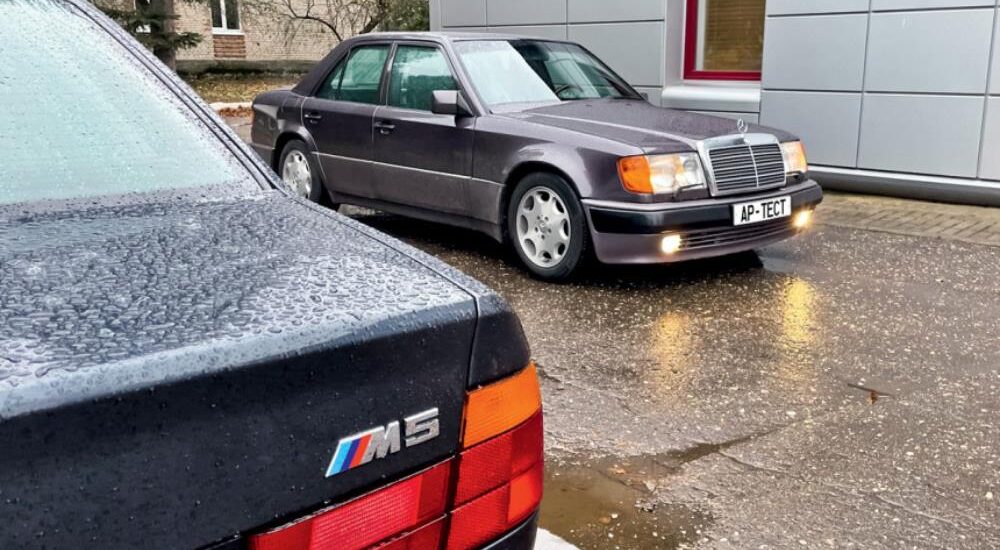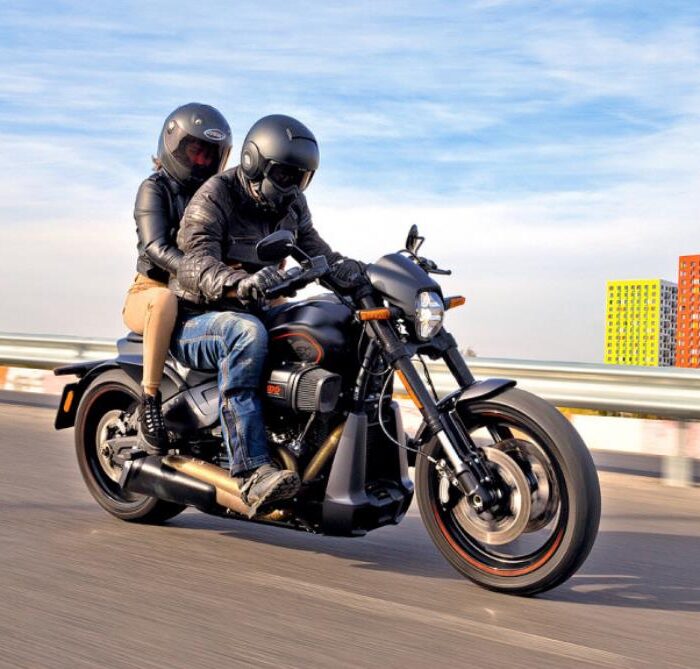Mercedes W124’ü duyurduğunda BMW buna E34 ile karşılık verdi. Münih’in cevabı M5’in ilanıyla yüksek ve netti ve Stuttgart da 500 E ile hızlı bir şekilde yanıt verdi. İlginçtir ki, bu süper sedanlar arasındaki keskin farklara rağmen, tuhaf bir başlangıç noktasını paylaşıyorlardı; her ikisi de yolculuklarına bir kamyon gövdesinde başlamıştı.

W124 projesi 1977’de Peter Pfeiffer ve Josef Gallitzendörfer tarafından hazırlanan ilk tasarımla başladı ve stil merkezi başkanı Bruno Sacco tarafından tamamlandı.
Rekabetin tonu inkar edilemez bir şekilde 1980’lerde Mercedes’i geride bırakma hırsıyla hareket eden BMW tarafından belirlendi. Rekabet o kadar şiddetliydi ki Münih, takibi sürdürmek için çabalarını ikiye katlamak zorunda kaldı. Avantaj elde etmek için bir atılım yapmaları gerekiyordu; bu, 1986’da E32 ‘Seven’ın ve bir yıl sonra da V12 motorlu BMW 750i’nin piyasaya sürülmesiyle geldi. O zaman asıl zorluk bu başarıyı ‘Beş’ ile tekrarlamaktı.
1988’de piyasaya sürülen E34 sedanlar, zorlu W124’ü geride bırakmak için tek bir odak noktasıyla üretildi. İlk çıkışından dört yıl sonra Mercedes hâlâ bir otomotiv mühendisliği harikası olarak varlığını sürdürüyordu. Retro testimiz sırasında, satış elemanlarını yeni ‘Five’ konusunda eğitmek için kullanılan bir bayi kataloğu olan BMW Praxis’i araştırdım. Bu 240 sayfalık kılavuz, E34 hakkında başka yerlerde nadiren bulunabilecek bilgilerle dolu bir ayrıntılar hazinesidir.
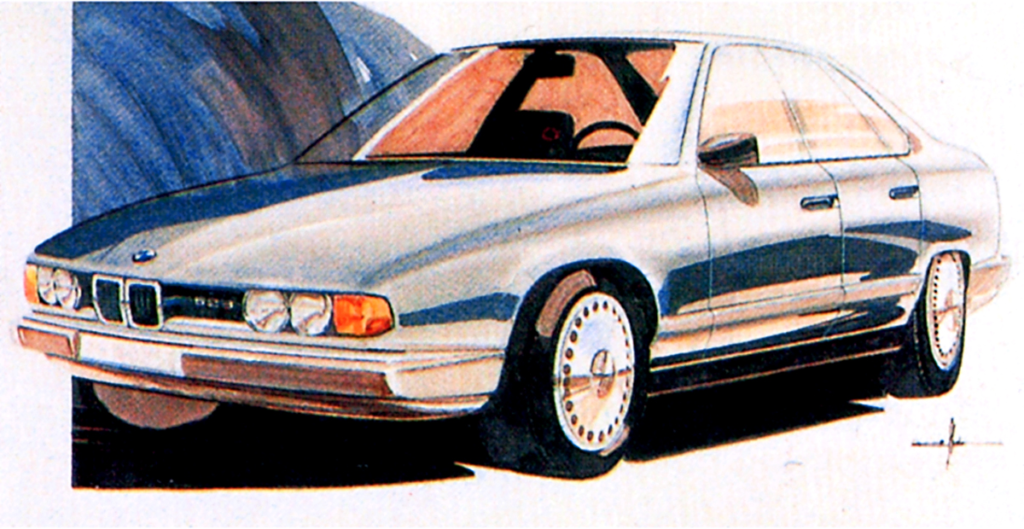
E34’ün İtalyan genleri 1982’de Ercole Spada tarafından çizildi. “Beş” üzerindeki çalışmalar Jay Mays tarafından sürdürüldü ve Klaus Luthe’nin rehberliğinde tamamlandı.
Pazarlama stratejilerinden teknik yeniliklere kadar rekabet yoğundu. BMW, çeşitli mesleklerdeki pazar paylarını analiz ederek, orta düzey yöneticiler arasında ‘Pervane’ ve üst düzey yöneticiler ile serbest çalışanlar arasında ‘Yıldız’ tercihine dikkat çekti. BMW aynı zamanda aerodinamikteki gelişmelerin de çığırtkanlığını yaparak selefine göre %18’lik bir iyileşme olduğunu ve 0,30’luk bir sürtünme katsayısına ulaştığını iddia ederken, aynı zamanda ikonik ızgara tasarımını da korudu. Kurnazca, standart lastik politikaları olmasaydı sonuçlarının daha da iyi olabileceğini ima ettiler; bu, en iyi aerodinamik değerleri daha dar lastiklerle elde eden Mercedes’e bir darbeydi.

BMW tarafından algılandığı şekliyle işlevsellik (dikey eksen) ve estetik (yatay eksen) arasındaki denge. Lancia’nın en az pratik olduğu, Audi’nin ise en az güzel olduğu ortaya çıktı.
Mercedes’in ön camın %86’sını temizleyen benzersiz silecek sistemi gibi yenilikler, BMW’nin temizleme alanıyla eşleşen ancak düşük hızlarda daha iyi bıçak performansı sağlayan bir mekanizma ekleyen uzatılmış silecekleriyle karşılandı. Benzer şekilde, Mercedes aynalar ve jetler için otomatik ısıtmayla övünürken, BMW, düşünceli bir mühendislik özelliği olan, kapı kolunun tutulmasıyla etkinleştirilen ısıtmalı bir kilit mekanizmasını tanıttı.

Şirketlerin ön uçla ne kadar farklı çalıştığı açıktır. Mercedes için optikler ve ızgara, kaldırma kuvvetini azaltmaya yardımcı olan aerodinamik bir araç görevi görür. BMW için farlar öncelikle markanın yüzüdür. Bununla birlikte, BMW Praxis kataloğu ilgi çekici rakamlar sunar: 180 km/s hızda hava direncinin üstesinden gelmek için E34’ün 64 hp’ye ve 200 km/s’de 87 hp’ye ihtiyacı vardır. Bu, benzer bir köpekbalığı burnuna sahip selefi E28’den %20 daha az.
Her model, diğerini geride bırakacak şekilde tasarlanmış özellikler içeriyordu. Mercedes’in ünlü beş bağlantılı arka süspansiyonu, elektronik olarak kontrol edilen amortisörler ve Servotronic direksiyon sistemi de dahil olmak üzere BMW’nin E34’ün mevcut kurulumundaki geliştirmeleriyle karşılandı. BMW ayrıca Mercedes’in ASR’sine, yalnızca çekişi değil aynı zamanda yavaşlama sırasında tekerlek kilidini de ele alan gelişmiş ASC+MSR sistemiyle yanıt verdi.
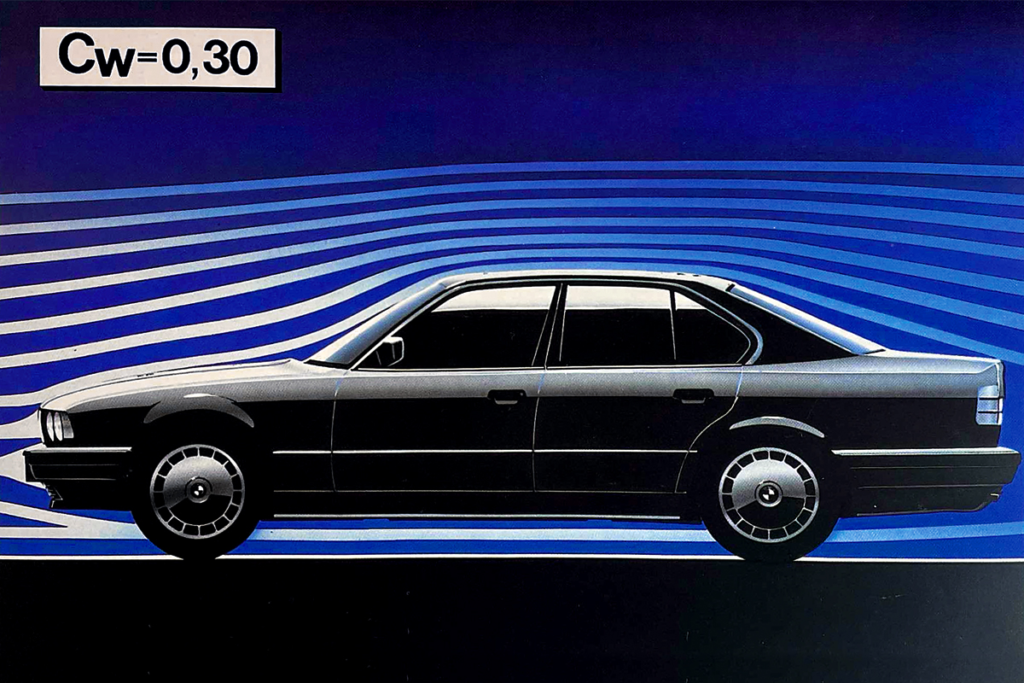
Katalog, M5’in yol tutuş özellikleri için bir gerekçe bile sağladı; bu, BMW’nin, muhtemelen Mercedes’in kuyruktan memnun doğasına karşı koymak için, gaz kelebeği girişi ile arkadan savrulmaya geçebilecek nötrden hafif dışa savrulmaya yönelik olarak şasiyi kasıtlı olarak ayarladığını öne sürdü.
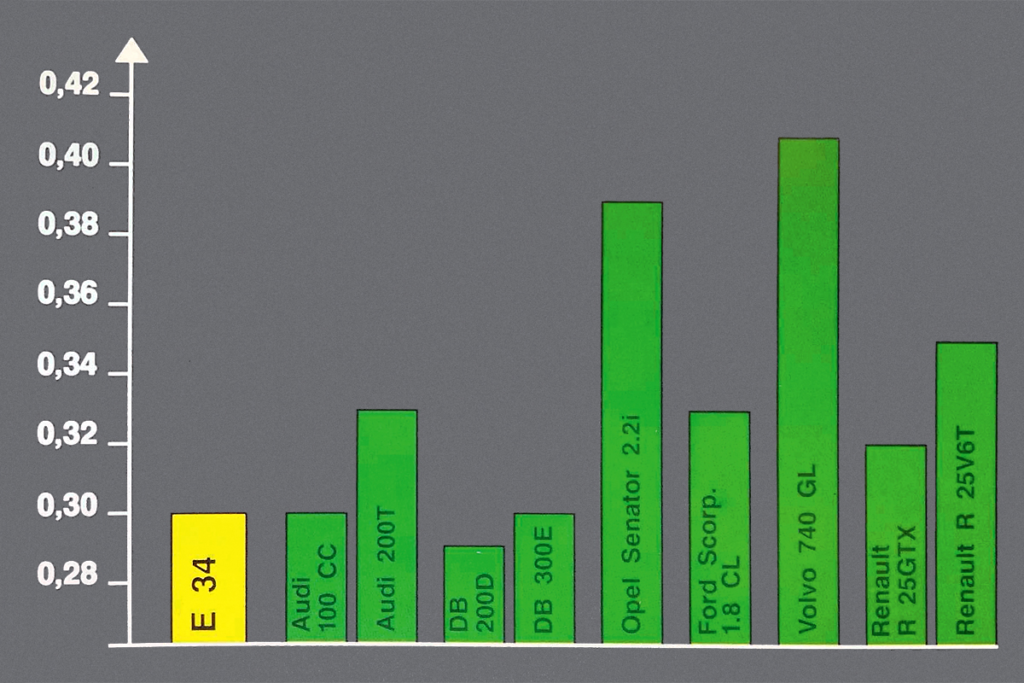
Hem klasiklerin hem de çağdaşların aerodinamiği. BMW, Mercedes’e yetişmek için çalışanlarını Audi’den çekti.
Devam eden bu üstünlük mücadelesi yalnızca teknolojik sınırları zorlamakla kalmadı, aynı zamanda köklü bir rekabetin de altını çizdi. E34 bir an için W124’ün önüne geçse de V12 E32’nin devrim niteliğindeki etkisini taklit edemedi. ‘Yedi’ ile aynı platformu paylaşmasına rağmen ‘Beş’ her zaman Stuttgart’taki muadilinin bir adım gerisinde görünüyordu ve Mercedes’in öncülük ettiği dört tekerlekten çekiş ve güvenlik iyileştirmeleri gibi yeniliklerin peşindeydi.
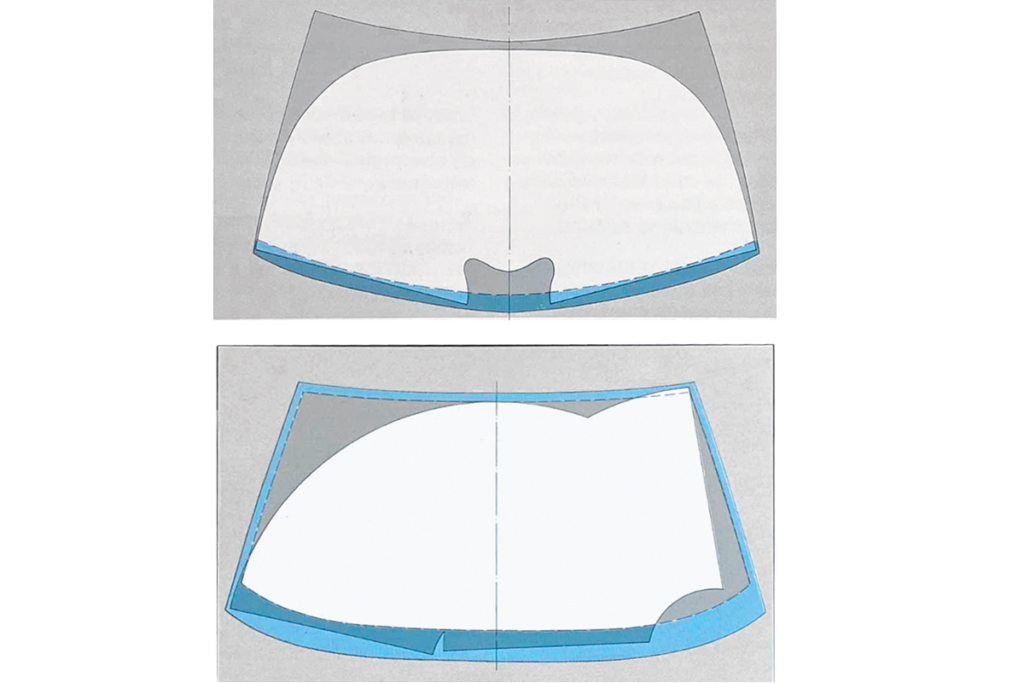
Mercedes’in sileceği üst köşelere ulaşıyor ve otomotiv endüstrisi için rekor bir ön cam temizleme alanı sağlıyor. BMW, trafik ışıklarında görünürlük için sol üst köşenin daha önemli olduğu konusunda ısrar ediyor.
BMW M5, otomotivde mükemmellik ve yenilikçiliğin amansız arayışını temsil eden bu şiddetli rekabetin bir kanıtı olmaya devam ediyor. Bu rakipler birbirlerini daha yüksek noktalara iterken, otomotiv dünyasına ilham vermeye devam eden bir mühendislik becerisi ve performans mirası bıraktılar.
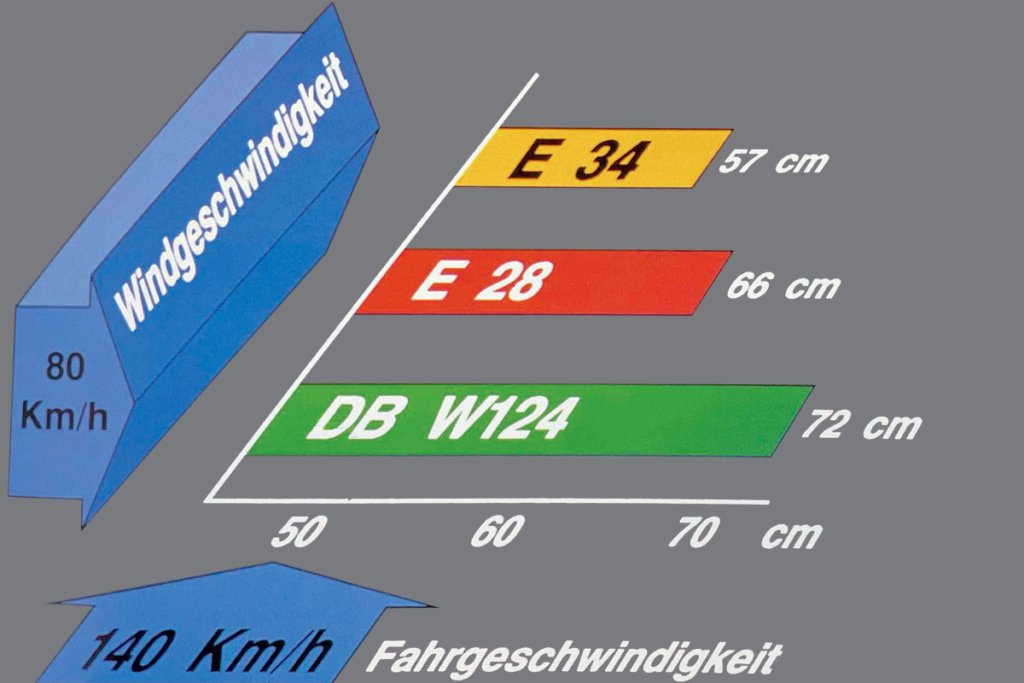
Mercedes’e karşı üstünlüğü vurgulamak için başka bir neden: yan rüzgarlarda E34, W124’ten daha az sürükleniyor.
Mercedes W124’ü tanıttığında BMW, kendi başyapıtı M5’in müjdesini veren E34 ile hızlı bir şekilde yanıt verdi. Stuttgart’ın tezgahı 500 E, her ikisi de şaşırtıcı bir kökene sahip olan birbirinden tamamen farklı iki süper sedan arasındaki büyüleyici rekabetin başlangıcını işaret ediyordu: her model hayatına bir kamyon şasisi üzerinde başlamıştı.
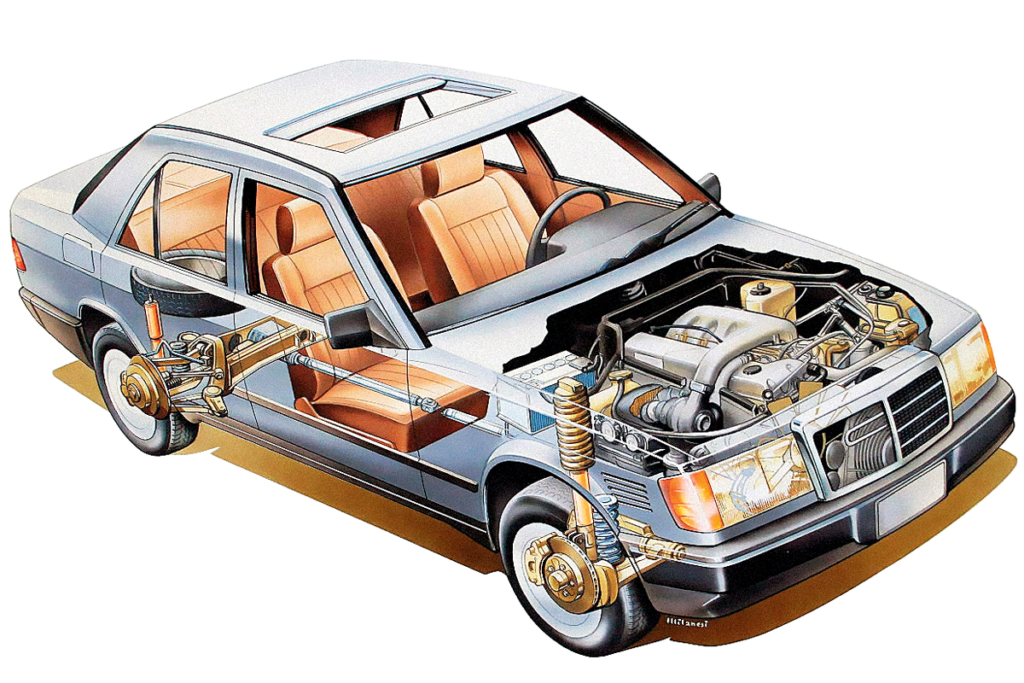
W124 şasisinin ana teknik cevheri, daha küçük sedanlar W201’de biraz daha önce ortaya çıkan ve daha sonra neredeyse tüm Mercedes binek otomobillerine takılan arka çok bağlantılı süspansiyondur. Diğer birçok üretici tarafından kopyalanmıştır. Değişikliklerle, bu temel beş bağlantı şeması bugün hala kullanılmaktadır.
1980’lerde BMW’nin hararetle Mercedes’i geçmeye çabaladığı yıllar görüldü. Stuttgart zorluydu ve Münih’i sırf ona ayak uydurmak için çabalarını ikiye katlamaya zorladı. Mercedes’i geçmek için BMW’nin olağanüstü bir şeye ihtiyacı vardı. 1986 yılında E32 ‘Seven’ın piyasaya sürülmesiyle teslimatı yaptılar ve bir yıl sonra V12 motorlu BMW 750i ile otomotiv dünyasını daha da şaşırttılar. Buradaki zorluk, bu başarıyı ‘Beş’ ile tekrarlamaktı.
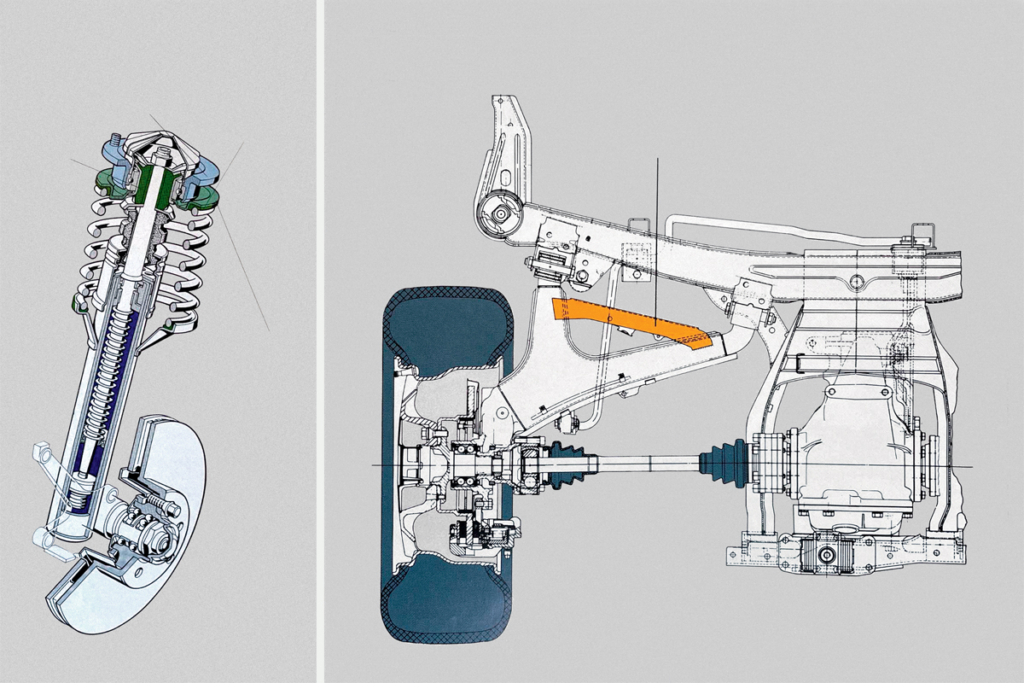
BMW 525i ve 524td’nin üzerindeki tüm E34 versiyonları için, ayrı yay ve amortisör bağlantılarına sahip McPherson destekleri sağlandı. Arkada, eğik kollar diş telleri ile güçlendirildi. Bu, eski tarz bir arka aksa sahip son “Beş” idi. Bir seçenek olarak, M5 hariç, daha sert bir Sport süspansiyon sunuldu.
1988’de piyasaya sürülen E34 sedanları tek bir hedefe odaklanmıştı: olağanüstü W124. Mercedes, piyasaya sürülmesinden dört yıl sonra hâlâ otomotiv mühendisliğinin zirvesini temsil ediyordu.
Geriye dönük testlerimiz sırasında, satış personelini yeni ‘Five’ konusunda eğitmek için tasarlanmış benzersiz bir bayi kataloğu olan BMW Praxis ile birkaç gün geçirdim. E34’ün bu 240 sayfalık İncil’i, aracın her dakika detayını ve tasarım kararını kapsıyor. Benzersiz bilgilerle doludur ve değerinin bir kanıtı olan 30.000 rublelik bir fiyatla satılmaktadır. Özellikle W124’ten neredeyse her sayfada bahsediliyor ve bariz bir takıntının altı çiziliyor.
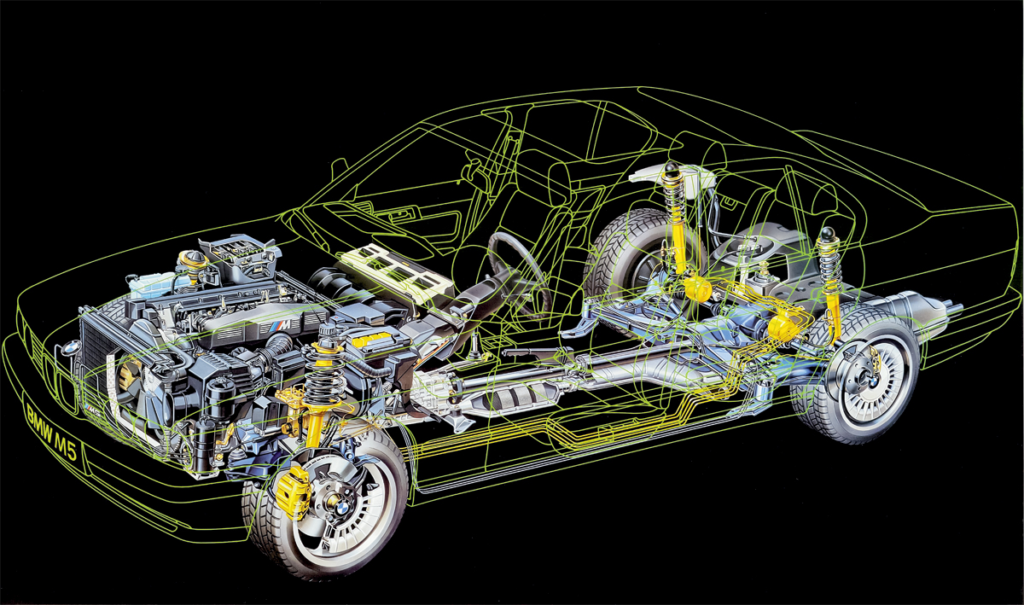
BMW’nin karşılaştırılabilir karmaşık çok bağlantılı süspansiyonu yalnızca 1989’da E31 coupe’de ve ardından “Yedi” E38 ve “Beş” E39’da ortaya çıktı. Ancak M5 E34, Mercedes 500 E piyasaya sürülmeden önce bile, sabit tekerlek kamber açılarını ve boşluğunu korumak için hidrolik otomatik tesviye mekanizmasına sahip arka amortisörlerle standart olarak donatılmıştı.
Mücadele, BMW’nin çeşitli meslek dalları arasında ayrıntılı pazar payı karşılaştırmaları yapmasıyla birlikte pazarlama stratejileriyle başladı. ‘Pervane’ markası orta düzey yöneticilerde daha fazla yankı uyandırırken, ‘Yıldız’ üst düzey yöneticiler ve serbest çalışanlar arasında popülerlik kazandı. BMW aynı zamanda mühendislik başarılarıyla da övünüyor, selefine göre önemli bir aerodinamik gelişme olduğunu iddia ediyor ve burun deliklerinin ikonik negatif eğimini korurken 0,30’luk bir sürtünme katsayısına ulaşıyor. Mercedes gibi rakiplerin optimum rakamlara ulaşmak için daha dar lastikler kullandığını ima ederek bu sonuçların daha da iyi olabileceğini ima etti.
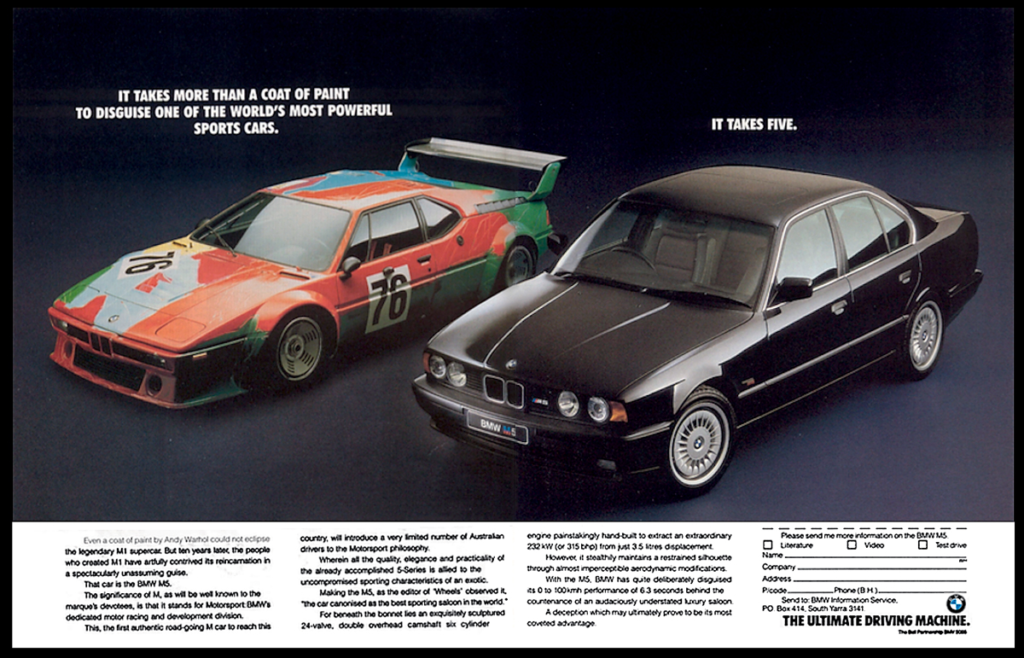
M5 motorlarının kökeni geleneksel olarak BMW M1’in “altı” M88’ine kadar uzanır, ancak gerçek atası BMW 3.0 CSL’dir. Kuru kartersiz M88/3 versiyonu Avrupa’da E28 M5’e tahsis edilirken, S38B35 etiketli ilk motor Amerika için “katalitik” versiyonuydu. E34’teki S38 motorları, bir demir blok ve 24 valfli bir DOHC kafasını miras aldı.
BMW, sileceklerin erişim alanını genişleterek ve tabana düşük hızlarda bıçak tutunmasını artıran bir mekanizma ekleyerek, camın %86’sını temizleyen Mercedes’in yenilikçi ön cam silecek sistemine uyum sağladı. Ayrıca, daha soğuk iklimler için akıllıca bir eklenti olan, kapı kolunun çekilip tutulması kilit ısıtıcısını etkinleştiren benzersiz bir özelliği de tanıttılar.
Yaylar yerine servolarla çalıştırılan katlanır arka koltuk başlıklarından hem çekiş kaybını hem de ani yavaşlamayı yöneten daha gelişmiş çekiş kontrol sistemine kadar BMW, yalnızca rekabet etmeye değil, aynı zamanda yeniliğe öncülük etmeye de kararlı görünüyordu. BMW, Mercedes’in ilerlemelerine yanıt verecek şekilde tasarımlarını sürekli olarak geliştirirken, her modelin yeni özellikleri diğerini geride bırakmayı hedefliyordu.
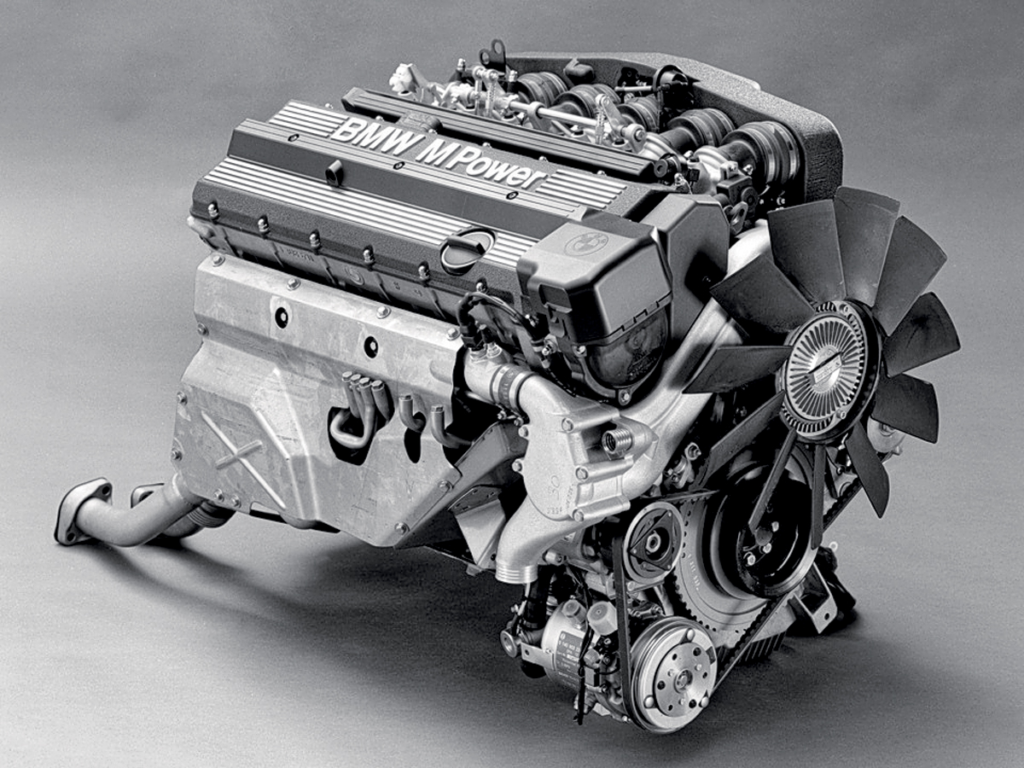
Makyaj öncesi M5’in S38B36 motoru (315 hp) aslında 3535 cc’lik bir deplasmana sahipti, ancak M5 E28’deki 3453 cc’lik bir deplasmanla önceki motordan ayırt etmek için 3.6 olarak adlandırıldı.
Dahası, BMW’nin kataloğu M5’in yol tutuş karakteristikleri için bir gerekçe sunmuş ve hızlanma sırasında arkadan savrulma durumuna geçebilecek nötrden hafif önden savrulmaya yönelik kasıtlı bir ayarlamaya işaret etmişti – belki de ‘124’ün ‘sürükleyici’ doğasına bir selam.
Bu kısasa kısas rekabeti sadece otomotiv teknolojisinin sınırlarını zorlamakla kalmadı, aynı zamanda iki marka arasındaki yoğun rekabet ruhunu da öne çıkardı. E34 kısa süreliğine W124’ün önüne geçmiş olsa da on iki silindirli E32’nin çığır açan etkisini taklit etmekte yetersiz kaldı. ‘Yedi’ ile aynı platformu paylaşmasına rağmen ‘Beş’ her zaman peşindeydi; steyşın vagon gövdeleri, dört tekerlekten çekiş ve Mercedes’in öncülük ettiği özellikleri hatırlatan gelişmiş güvenlik özellikleri gibi yenilikleri benimsiyordu. BMW M5, rekabetin otomotiv endüstrisinde yeniliği ve mükemmelliği nasıl teşvik ettiğini gösteren bu şiddetli rekabetin bir anıtı olmaya devam ediyor.
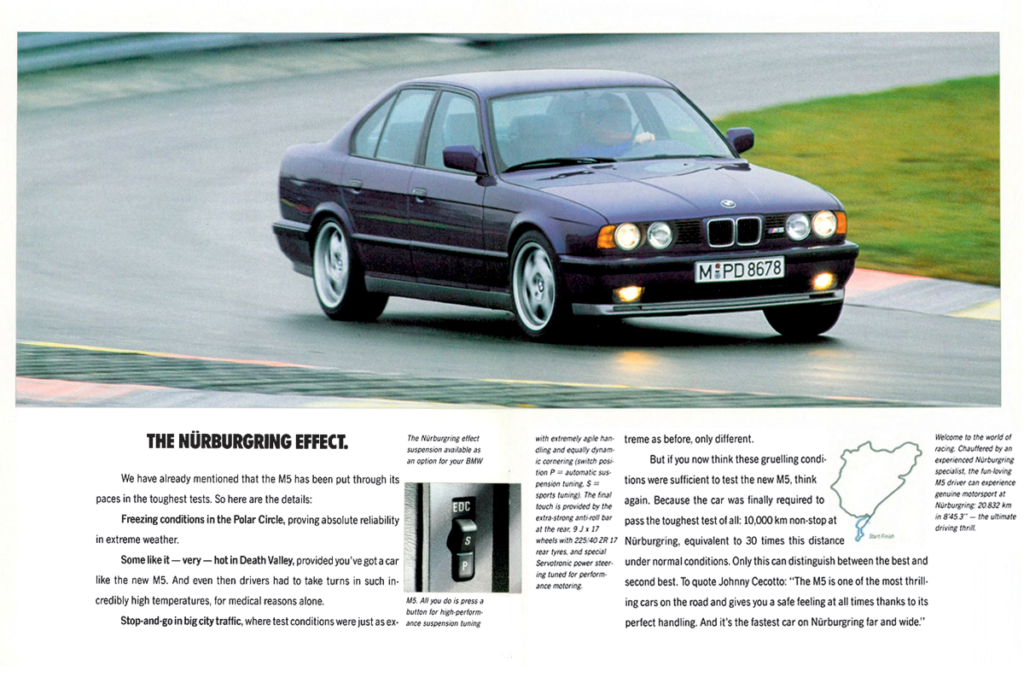
Nürburgring etkisi, testler sırasında uyarlanabilir EDC amortisörlü BMW M5 sedan’ın Nürburgring’in “Kuzey Döngüsü”nde kesintisiz on bin kilometreyi tamamladığı ve 8’45.3” (20.832 km’lik bir pistte) ile en iyi zamanı kaydettiği anlamına geliyor.
Üç yıl önce, Mercedes 500 E’nin 30. yıldönümünü kutlamak için Porsche’nin basın servisi, Typ 2758’in proje lideri Michael Hölscher ile bir röportaj yayınladı. Hölscher’in sonraki podcast görünümleri, bu ikonik modelin gelişim nüanslarına daha fazla ışık tuttu. Kendisi, sedanın düzeninin, 500 SL roadster’dan motor ve şanzıman seçiminin yanı sıra tasarımı ve aerodinamiğinin tamamen Mercedes tarafından belirlendiğini açıkladı. Porsche’nin görevi öncelikle bu bileşenlerin, başlangıçta V8 motorları barındıracak şekilde tasarlanmamış olan W124 şasisine entegrasyonuydu.
Bu işbirliği, giriş kanallarının yeniden konumlandırılması, fren ve yakıt hatlarının yeniden yönlendirilmesi, merkezi tünelde ayarlamalar yapılması, pistin genişletilmesi ve kapsamlı bir sürüş testi programının yürütülmesi dahil olmak üzere önemli uyarlamalar gerektirdi. İlginç bir şekilde Mercedes, müşterinin spesifikasyonlarının Porsche için çok önemli olduğu bir senaryonun altını çizerek bu projeye Nürburgring ayarını dahil etmemeyi tercih etti.
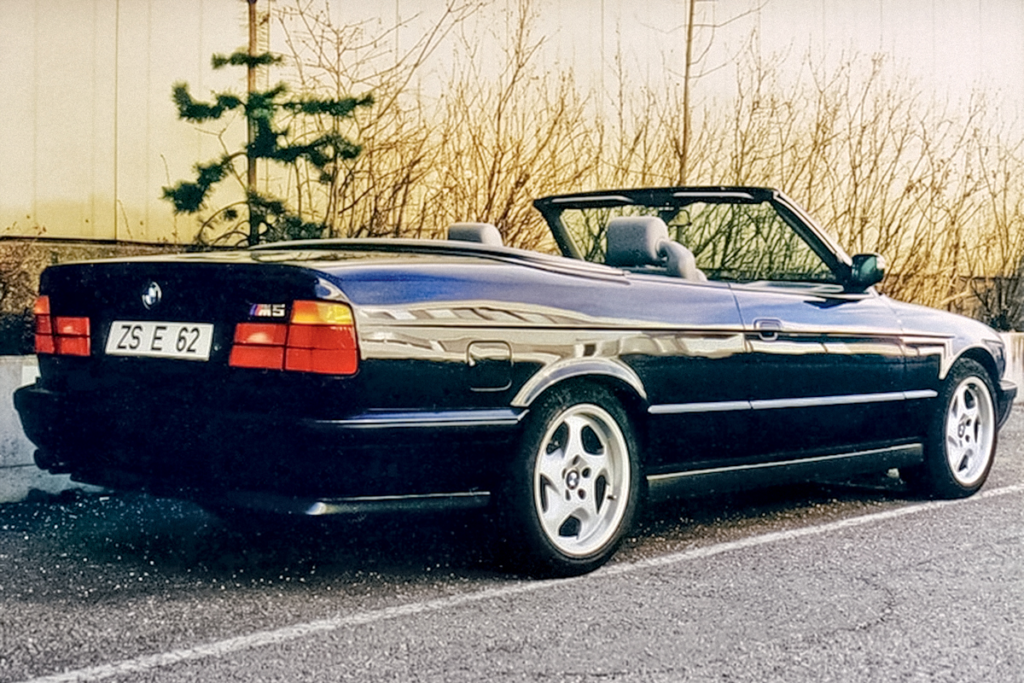
1989 Cenevre Otomobil Fuarı’nda, E35 gövdeli üstü açılır bir M5’in gösterilmesi gerekiyordu, ancak prömiyerden bir hafta önce BMW, açık M3’e olan talebe zarar vereceğinden korktu ve projeyi iptal etti. Prototip sadece 2009 yılında tanıtıldı.
Zuffenhausen’in dikkate değer bir yeniliği, elektronik motor yönetim sisteminin geliştirilmesiydi. Gerçekten de 500 E, CAN-bus sistemiyle donatılmış ilk araç olması nedeniyle hem Mercedes hem de Porsche için öncü oldu.
Hölscher ayrıca, Porsche tarafından tasarlandığı söylenen aşırı geniş ön çamurlukları nedeniyle 500 E’nin Sindelfingen montaj hattına yerleştirilemeyeceği yönündeki efsaneyi de çürüttü. Bu çamurlukların aslında montaj hattındaki kısıtlamaların çok iyi farkında olan Mercedes tasarımcıları tarafından tasarlandığını açıkladı. Sindelfingen fabrikasının ekipmanını daha geniş çamurluklar için yenilemek yerine belirli üretim aşamalarını Porsche’ye yaptırmak, uygun maliyetli bir stratejiydi. Bu ilginç bir olasılığı gündeme getiriyor: Belki de Mercedes, bu özel sedanın, BMW’nin yaklaşımına benzer şekilde, standart üretim hatlarından uzakta, benzersiz bir yerde monte edilmesini amaçlamıştı.
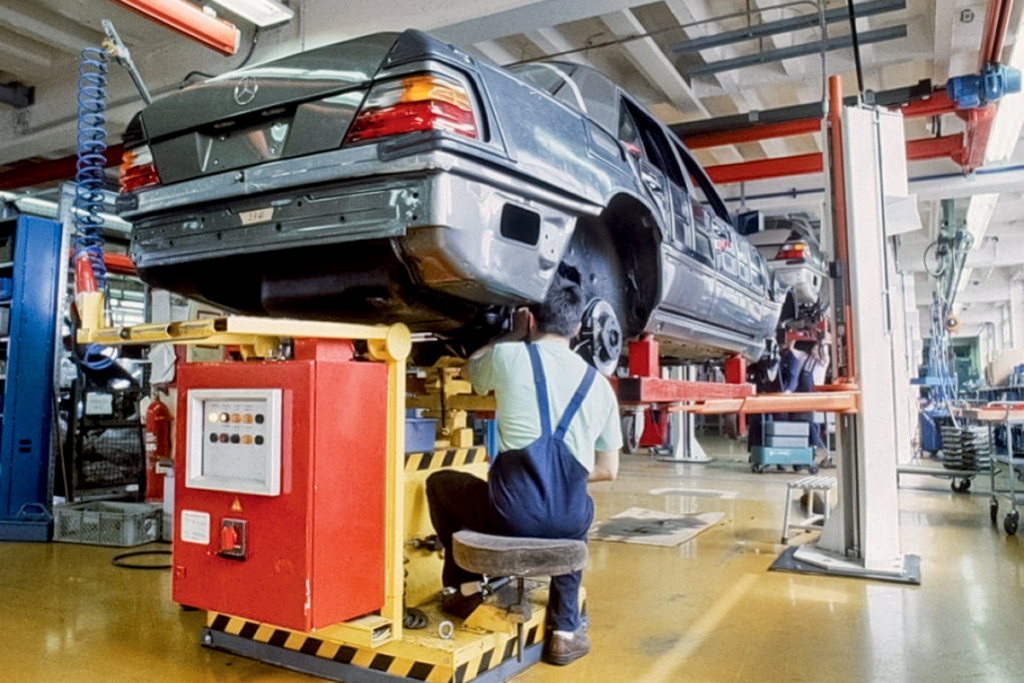
Porsche fabrikasında, Mercedes arabaları konveyörsüz, asansörlere ve arabalara monte edildi. Bu arabaların VIN kodu 124.036 rakamlarını içermelidir.
Sonuçta Mercedes 500 E üç lokasyonda monte edildi. Damgalı gövde panelleri, Sindelfingen’den Zuffenhausen’e kamyonlarla taşındı; burada Porsche, Reutter Bau binasında parçalar ekledi ve bunları çerçeveler halinde birleştirdi. Adını 1906’dan beri Ferdinand Porsche ile çalışan ve ilk Porsche otomobilinde önemli bir rol oynayan tarihi Reutter Karosseriewerk’ten alıyor. bedenler. İlk montajın ardından çerçeveler boyama için Sindelfinden’e, ardından daha önce Porsche 959 üretimine ev sahipliği yapan Rössle Bau fabrikasında son montaj için Zuffenhausen’e geri gönderildi.
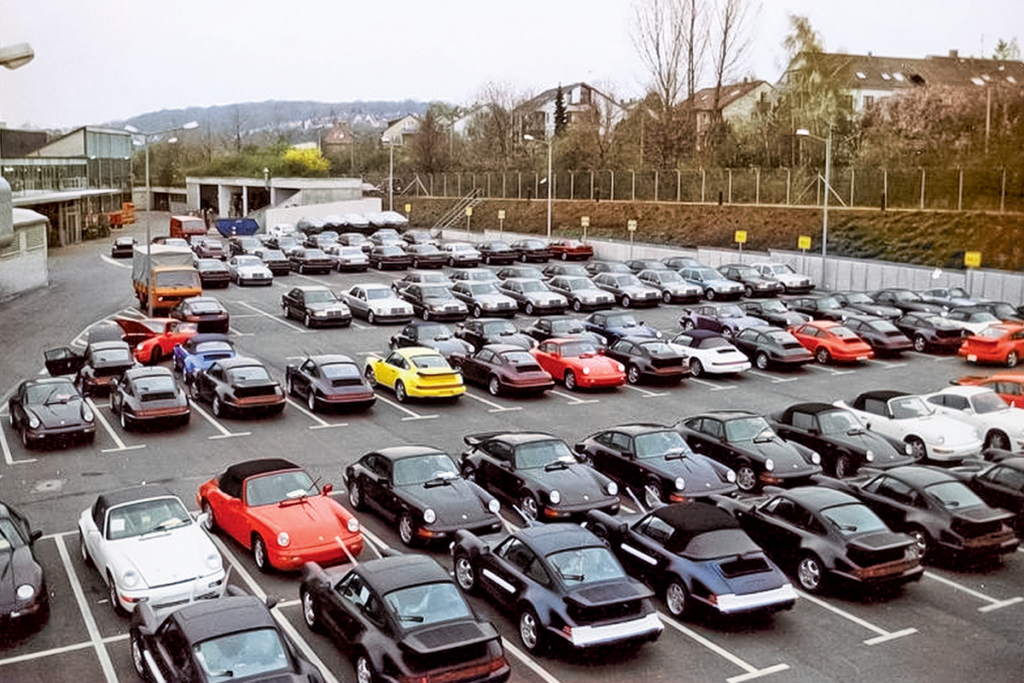
90’ların başı, Zuffenhausen’deki fabrikada bitmiş ürünler: arka planda çeşitli Porsche 964’ler ve kırk Mercedes.
Bu sürecin lojistik karmaşıklığı oldukça fazlaydı; her bir aracın üretimi 18 gün sürdü. Buna rağmen üretim sürecinin BMW M5’inkinden daha verimli olduğu kanıtlandı. Mercedes başlangıçta Porsche’nin günde on araba üretmesini planladı, ancak yoğun talep nedeniyle üretim oranları iki katına çıktı.
1992 yılında talebin ve üretimin zirve yaptığı, 135.000 Alman Markı ile S-sınıfından daha yüksek bir fiyata sahip olan 500 E, tüm “124” serisini E-sınıfına dönüştüren 1993 makyajının bir parçası olarak kısa süre sonra E 500’e geçiş yaptı. . Mühendislik aynı kalsa da, fiyatın 146.000 Mark’a yükselmesi satışlarda düşüşe yol açarak 1995 yılında üretimin durdurulmasıyla sonuçlandı. Ancak daha az güçlü olan 400 E (daha sonra E 420) 1996 yılına kadar iki kat sayıyla devam etti.
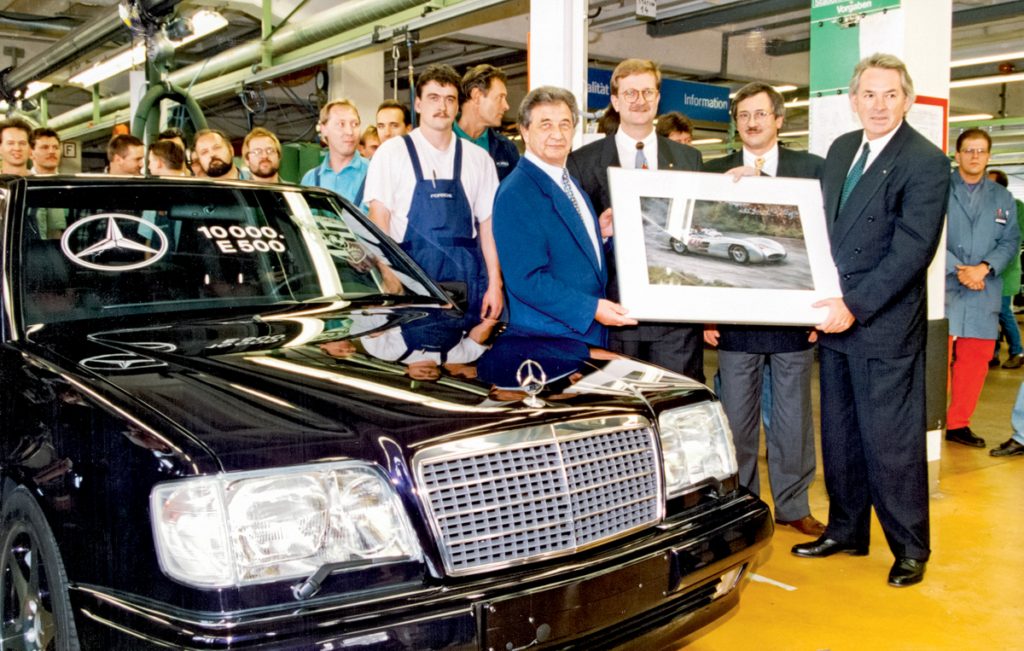
10.000’inci “Beş Yüz” Mercedes, Ekim 1994’te üretildi ve makyajlı endeks E 500 ile üretildi. Bundan sonra, 479 ünite daha monte edildi. Araba, 50’li yıllarda Formula 1’de Mercedes için yarışan ve 1970 yılında Porsche için ilk Le Mans’ı kazanan Hans Herrmann’a hediye edildi.
Bu proje yalnızca Porsche’nin mali durumunu istikrara kavuşturmakla kalmadı, aynı zamanda Porsche’nin daha büyük bir mühendislik etkisi uyguladığı Audi RS2 gibi gelecekteki projelere de zemin hazırladı. Michael Hölscher’in liderliği bu projenin ötesine geçerek 2016’da emekli olmadan önce Carrera GT ve Porsche 918 Spyder’ın geliştirilmesine katkıda bulundu.
500 E projesi aracılığıyla performans modellerinin kazançlı doğasını fark eden Mercedes, 1993 yılında otomotiv sektörünün bu “havyarını” özel tutmaya karar verdi ve bu, ilk Mercedes C 36 AMG’nin piyasaya sürülmesine yol açtı ve gelecekteki yüksek teknolojiye zemin hazırladı. Bugün iyi bilinen performans yenilikleri.
Fotoğraf: BMW | Mercedes-Benz | Sergey Znaemsky ·
Bu bir çeviridir. Orijinal makaleyi buradan okuyabilirsiniz: Эхо друг друга: как создавались BMW M5 и Mercedes-Benz 500 E из нашего ретротеста

Yayımlanmış Haziran 20, 2024 • Okuma süresi: 13 dakika

